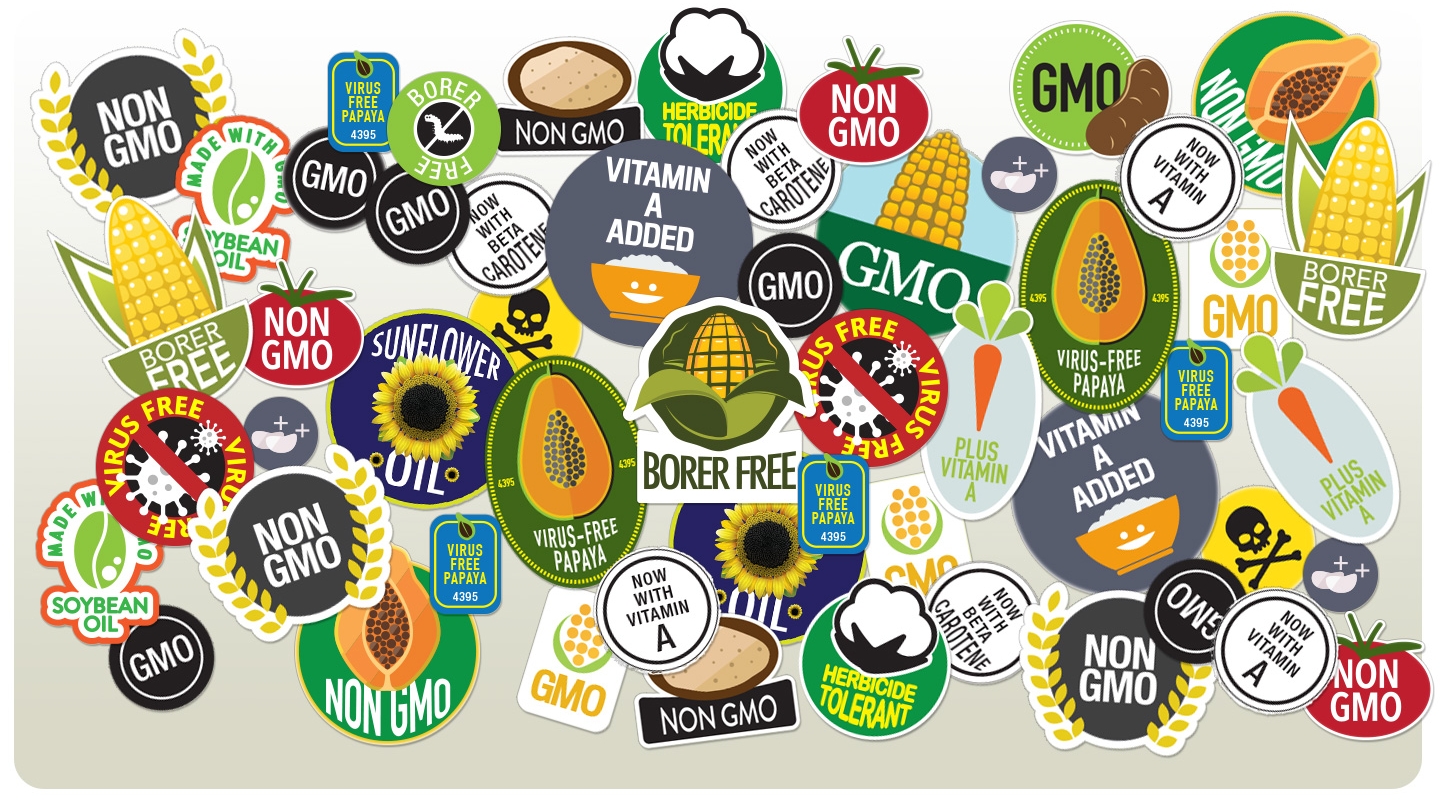By Dr Senani Wijesena – 26/06/2016
What is GMO?
According to the World Health Organization, Genetically modified (GM) foods are foods derived from genetically modified organisms (GMO’s) whose genetic material (DNA) has been modified in a way that does not occur naturally by mating and/or natural recombination, e.g. through the introduction of a gene from a different organism. Currently available GM foods stem mostly from plants, however, in the future foods derived from GM microorganisms or GM animals are likely to be introduced on the market. Most existing genetically modified crops have been developed to improve yield, through the introduction of resistance to plant diseases or of increased tolerance of herbicides such as glyphosate (Roundup).
In Australia, the following foods/crops have been approved for GM growing and include soybean, corn (maize), sugar beet, wheat, potato, rice, canola, cotton and lucerne. The approval is primarily for herbicide tolerance and insect protected GM varieties. In the USA, 144 different crops have been approved for genetic modification and include in addition to the above, a variety of fruits and vegetables such as strawberry, papaya, alfalfa, squash, apples, eggplant, tomatoes, lettuce, cantaloupe and carrots.
GMO Foods/crops
Genetically modified corn is used to produce many different ingredients used in processed foods and drinks, including the sweetener high-fructose corn syrup and cornstarch as well as corn oil. However, the bulk of the GM corn grown around the world is used to feed livestock/meat produce. Some is also converted into biofuels.
The majority of corn and soybean grown in the USA and Australia is genetically modified. GM soy is used primarily in animal feed and in soybean oil—which is widely used for processed foods and in restaurant chains. In fact, soybean oil accounts for 61% of Americans’ vegetable-oil consumption and is also produced and consumed in Australia, although not as widely as canola and cottonseed oil. Soybean is often used to make an emulsifier called soy lecithin, which is present in many processed foods, including dark chocolate bars and candy. Most non-organic Soymilk and tofu sold in Australia and worldwide is genetically modified, either from local production or imported. GM soybean products are used in numerous processed foods, including bread, chocolate, potato chips, pastries, margarine and mayonnaise.
In Australia, most canola oil also uses genetically modified organisms in its production. Genetically modified canola has been produced in Australia since 2003.
Canola oil is a key ingredient in many foods and is sold directly to consumers as margarine or cooking oil and in canned and snack foods. The oil has many non-food uses, which includes making lipsticks and the meal residue is used as livestock feed.
Cotton seed oil from GM cotton in Australia and the USA is often used in cooking, frying in restaurants and in packaged foods like potato chips, oily spreads such as margarine, and certain canned foods while cottonseed meal is used to feed livestock. Other parts of the plant are used in the production of food fillers such as cellulose.
Foods imported into Australia are more likely to be genetically modified and include soybeans, corn, rice, potatoes and sugar beet.
GM Sugar beet is used to produce 50% of refined sugar/mollases and is herbicide (glyphosate) resistant to tolerate high application of the chemical. Sugar beets that are herbicide-tolerant have been approved in Australia, Canada, Colombia, EU, Japan, Korea, Mexico, New Zealand, Philippines, Russian Federation, Singapore and USA. The sugar produced from GM sugar beets is highly refined and contains no DNA or protein—it is just sucrose, the same as sugar produced from non-GM sugar beets. The pulp remaining is used as animal feed.
Field Trials for GM Pineapple, Papaya, Sugarcane, Barley and Bananas are also currently underway in Australia.
Labelling of GMO foods
Approximately 60 per cent of our processed foods can contain GM ingredients. Corn is 90 per cent GM in the US, and if that is used in Australian-manufactured biscuits or bread, no labelling is required as the USA food manufacturing and produce industry is not legally bound to include this. Unlike regulatory bodies in 64 other countries, the Food and Drug Administration (FDA) in the USA does not require labelling of GM foods.
In Australia, GM foods, ingredients, additives, or processing aids that contain novel DNA or protein must be labelled with the words ‘genetically modified’. Novel DNA or protein is defined in the Food Standards Code as DNA or a protein which, as a result of the use of gene technology, is different in chemical sequence or structure from DNA or protein present in counterpart food, which has not been produced using gene technology. Labelling is also required when genetic modification results in an altered characteristic in a food, e.g. soybeans with changed nutritional characteristics such as an increase in their oleic acid content. All GM foods and ingredients must undergo a safety assessment and be approved before they can be sold in Australia and New Zealand.
The decision on how GM foods are labelled was made by the ministers responsible for food regulation in 2001. GM foods that do not contain any novel DNA or protein or altered characteristics do not require labelling. A decision not to label these foods was made because the composition and characteristics of these foods is exactly the same as the non-GM food. These foods are typically highly refined foods, such as sugars and oils, where processing has removed DNA and protein from the food, including novel DNA and novel protein. Flavours containing novel DNA or protein in a concentration of no more than 0.1% are also exempt from labelling. Labelling is also not required according to the FSANZ if the product contains less than 1% of genetically modified foods inadvertently or via contamination.

GMO foods and problems including health effects
Proponents of genetically engineered foods state that the technology is utilized to improve plant resistance to abiotic stresses, such as drought, extreme temperature or salinity, and biotic stresses, such as insects and pathogens, that would normally prove detrimental to plant growth or survival.
The protein encoded by the altered gene will confer a particular trait or characteristic to that plant. It is well known that genetically modified food production costs are more expensive than non-GM food production.
Despite these probable benefits there is no adequate scientific evidence showing that GM plants/food are toxicologically safe and were introduced to food manufacturing without thorough testing and a number of concerns and potential negative health impact have been identified, including:
- Current efforts are focused primarily on a few crop/trait combinations e.g. herbicide resistance that have high commercial value and occupy large international markets, hence are primarily profit driven.
- Public Institutions are resource limited and lack infrastructure and capacity to compete; there is poor access to advanced technology and weak regulatory capacity.
- Potential for unpredictable, unintended mutations in the organism with consequential medico-legal events.
- Tendency to provoke allergic reactions. New pesticide residue effects in alimentary system may affect gut bacteria provoking peripheral immune and allergic reactions.
- GM foods including the pesticide used (glyphosate) have also been associated with damage to the intestinal wall, altered intestinal permeability and impaired digestion and impaired liver detoxification (glyphosate inhibits Cytochrome P450 liver enzyme)
- Most of the trials supporting introduction of GMOs are not independently done and are commercially driven. The trial designs are laboratory design and of short duration. Short-term studies may mask chronic toxicological effects including later developmental and reproductive effects.
- Increasing trends in organ disease and GMOs use have been observed in studies. There is some correlation between organ disease, increasing GMO in food supply, and glyphosate herbicide application with possibility of endocrine disruption. Organ disease mentioned include: Thyroid cancer; Liver and Intra hepatic bile duct cancer; Hypertension; Acute kidney disease; Diabetes mellitus; Autism; Alzheimer’s disease; Parkinson’s disease; Senile dementia; Inflammatory bowel disease – Crohn’s and Ulcerative colitis; Rheumatoid arthritis. Though these have not been directly proven yet there is need to keep an eye on the correlation through further observational and epidemiological studies.
Two recent developments are dramatically changing the GMO landscape. First, there have been sharp increases in the amounts and numbers of chemical herbicides applied to GM crops, and second, the International Agency for Research on Cancer (IARC) has classified glyphosate, the herbicide most widely used on GM crops, as a “probable human carcinogen” and classified a second herbicide, 2,4-dichlorophenoxyacetic acid (2,4-D), as a “possible human carcinogen.” These classifications were based on comprehensive assessments of the toxicological and epidemiologic literature that linked both herbicides to dose-related increases in malignant tumors at multiple anatomical sites in animals and linked glyphosate to an increased incidence of non- Hodgkin’s lymphoma in humans.
Glyphosate has also been noted to be weakly estrogenic and has additive hormonal effects with genistein from soybeans with studies indicating it may increase the risk of hormone dependent breast cancer. This oestrogen mimicking effect can cause a number of problems including an increased risk of various other cancers, early onset of puberty, thyroid disease and infertility.
Reports have been made of neural defects and craniofacial malformations from regions where glyphosate-based herbicides have been used and animal studies indicate direct effect of glyphosate on early mechanisms of morphogenesis in vertebrate embryos. This opens concerns about the clinical findings from human offspring in populations exposed to glyphosate in agricultural fields. In humans, only small amounts (~2%) of ingested glyphosate are metabolized to aminomethylphosphonic acid (AMPA), and the rest enters the blood stream and is eventually eliminated through the urine.
More recent greenhouse experiments demonstrated that glyphosate application to the root system decreased the levels of calcium, magnesium, iron and manganese in the seeds of the plants. It was proposed that glyphosate binds to and immobilizes all of these divalent micronutrients, impairing their uptake by the plant. These glyphosate-induced deficiencies would carry over to the food supply, leading to deficiencies in these nutrients in humans who consume foods derived from glyphosate-exposed crops.
Herbicide resistance (primarily to glyphosate- Roundup) is the main characteristic that the biotechnology industry has chosen to introduce into genetically modified plants. Their advantage, especially in the first years after introduction, is that they greatly simplify weed management. Farmers can spray herbicide both before and during the growing season, leaving their crops unharmed leading to over reliance on herbicide.
Global use of herbicides has increased by a factor of more than 10. Not surprisingly, glyphosate-resistant weeds have emerged and fields must now be treated with multiple herbicides, including 2,4-D, a component of the Agent Orange defoliant used in the Vietnam War. Enlist Duo, a new combination herbicide comprising glyphosate plus 2,4-D has been formulated and approved to combat herbicide resistance. It will be marketed in tandem with newly approved seeds genetically engineered to resist glyphosate, 2,4-D, and multiple other herbicides. The EPA anticipates that a 3-to-7-fold increase in 2,4-D use will result. This is a cause for concern considering that the IARC determined in 2015 that both herbicides are probable carcinogens.
Glufosinate is another herbicide (weed controller) used on genetically modified crops such as wheat, potato, soybean and corn and its metabolite is MMPA. Livestock feed such as GM maize and soymeal are contaminated with glufosinate. Studies have shown that MMPA is a neurotoxin and it has been detected in maternal and fetal blood samples of humans consuming contaminated meat. This toxin cannot be effectively eliminated by humans and has been shown to cause growth retardation, congenital malformations and increased death in animal studies and is of concern in humans exposed to GM foods. Other toxins from GMO foods such as Monsanto’s Bt toxin and pesticides have also been found in maternal, fetal and non-pregnant women’s blood according to studies.
In addition, other studies have identified the presence of fragments of foreign DNA from genetically modified foods in the human blood stream as well as animal studies and are of cause for concern as the implications of this finding are currently unknown and require further investigation.






